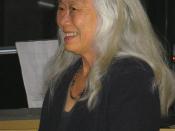?No Name Woman? Maxine Kingston's memoir, The Woman Warrior describes the struggles of a Chinese-American woman growing up as she attempts to find a balance between two cultures and to find her own identity within them. Kingston's novel abounds with imagery, from the ghosts and barbarians, to the different colors (black, white, and red). Every character is introduced in a way to clarify Kingston's motives for writing. Through her stories, she makes it evident that she experiences many conflicts between what she is being taught at home and what she is experiencing in American society.
Kingston clearly establishes her beliefs and values of Chinese culture in each story and then points out the contrasts with American culture. Her mother wants to instill traditional Chinese values in her daughter, with the desire that her daughter become a strong, unique individual - a ?woman warrior.? This story describes the shunning of the aunt who has an affair with, and becomes pregnant by, an unnamed man in her village.
The seriousness of her betrayal was conveyed through the repeated words like ?forbidden,? ?alone,? and ?separate.? ?The villagers punished the aunt for acting as if she could have a private life, secret and apart from them? (p.13).
The Chinese culture is initially portrayed as brutal and ever present in Kingston?s home where ?even now China wraps double binds around [her] feet? (p.48). She explains her fears of not being good enough in her mother?s eyes when she tells us, ? we Chinese girls listened to the adults talk-story, we learned that we failed if we grew up to be but wives or slaves (p.19). In the chapter entitled ?White Tigers,? Kingston explores the tale of Fa Mu Lan, a daughter who took her father?s place in the war against the Han. Through this story, Kingston realizes that being a failure (wife or slave) for a female is traditional in the Chinese culture and therefore recognizes the importance of becoming stronger and unique. ?She said I would grow up a wife or slave, but she taught me the song of the warrior woman, Fa Mu Lan. I would have to grow up a warrior woman,? (p.20). She also recognizes her mother as being a warrior. Brave Orchid, Kingston?s mother, was an important figure in her village back in China; she had attained a doctor?s degree. ?I?m never getting married, never!? ?Who?d want to marry you anyway? Noisy. Talking like a duck. Disobedient. Messy. And I know about college. What makes you think you?re the first one to think about college?? (p.202). Brave Orchid hints to her daughter that getting married is a tradition that is to be taught but not necessarily followed; like her mother, Kingston has the opportunity to be an individual.
As a Chinese-American woman, Kingston seeks to balance the two ideals of tradition and individuality. The American culture creates a force that pulls her away from her mother, and away from being traditional. She sees that women in traditional Chinese cultures are silenced and they have no real voice. ?Women in the old China did not choose. Some man had commanded her to lie with him and be his secret evil... She obeyed him; she always did as she was told? (p.6). Kingston is taught that most Chinese women have no control over their lives; that they are mere puppets. So insignificant are they, that her aunt becomes ?one of the stars, a bright dot in blackness, without a home, without a companion, in eternal cold and silence? (p.14). The aunt?s sins make her become a spirit without a home and no longer has any importance in her society.
America is portrayed as a place of corruption and evil. The description of non-Chinese people as ?ghosts? implies that they are barbarians or demons. By calling all non-Chinese people ?ghosts,? the mother categorizes these individuals just as the village did the ?No Name Woman,? as unacceptable and undesirable by the Chinese culture. ?America has always been full of machines and ghosts? (p.96-97). Kingston uses the word machines to signify the bombing planes of World War II, which haunted her in her childhood dreams. However, America is Kingston?s home. She is confused about how she can live in a culture she cannot accept nor be accepted by. In order to appear ?American-normal,? Kingston tells how ?we American-Chinese girls had to whisper to make ourselves American-feminine? (p.172). This attitude illustrates the need and desire to fit into the American culture, no matter how America is presented by her Chinese family relatives.
The differences between the Chinese and American cultures create enormous barriers faced by Chinese-Americans. Language is one such barrier that Kingston struggles to overcome, and her silence initially causes her to flunk kindergarten. The difference between the two languages causes Kingston to experience difficulties in learning English. ?It was when I found out I had to talk that school became misery, that the silence became misery? (p.166). As a child, Kingston?s efforts to be heard within her home and family were ignored because of the difficulty she experienced speaking out loud. She realized that ?the other Chinese girls did not talk either, so [she] knew the silence had to do with being a Chinese girl? (p.166), especially since young girls had been raised to lack confidence and a feeling of self-worth. ?You don?t see I?m trying to help you out, do you? Don?t you ever want to be a cheerleader? Or a pompom girl? What are you going to do for a living? Yeah, you?re going to have to work because you can?t be a housewife? (p.180-181). This dramatic scene near the end of the book creates a sense that Kingston is trying to ?save? someone from becoming a traditional Chinese girl. Kingston recognizes herself in this girl and hates it. She is able to step outside of herself and to see what she has become.
The combination of both American and Chinese values in Kingston?s voice demonstrates the desire for balance between the different cultural practices. The Woman Warrior shows two distinct societies, with many opposing values. The combinations of cultural practices influence Kingston?s sense of identity and individualism. At the end of the book, Kingston?s ability to find her voice and speak out to the girl in the basement emphasizes her newfound individuality. She was once that girl and experienced that misery of learning English, but ultimately Kingston finds her place in the American society. Kingston learned that she had many misconceptions of the Chinese culture due to her immaturity as a young girl. ??Have you eaten rice today, little girl??... ?Yes, I have,? I said out of politeness. ?Thank you.? (?No, I haven?t,? I would have said in real life, mad at the Chinese for lying so much. ?I?m starved? (p.21). As a child, she believed that saying such things were wrong. However, as Kingston matured, she learned that what she was taught and practiced was custom. She begins to recognize the many instances in which she prejudged her mother.
Finally, once she was able to reflect on her childhood by herself, she was able to truly comprehend both cultures and to find that she was part of both. Her ability to blend these two cultures into a single identity leads to achieving her mother?s goal, becoming a strong individual. She has realized by writing this memoir who she is. She may not feel as if she is a part of the American culture and she may still find many of its aspects to be confusing and strange. However, she is able to incorporate her own traditional culture with the strange and ?barbaric? America in which she lives. She finds her identity to be a mixture of cultures, as a Chinese-American woman- a woman warrior. And, ?It translated well,? (p.209).





